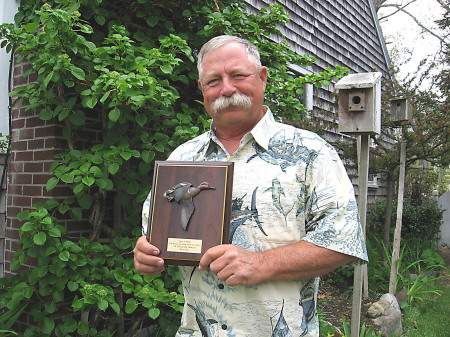Maintaining 200 birdhouses in town a 'labor of love'
By Liz Premo
Hampton Union, May 14, 2013
[The following article is courtesy of the Hampton Union and Seacoast Online.]

Retired Hampton firefighter Dave Weber displays the 2013 Habitat Stewardship Award
of Excellence he received from the NH Fish & Game Department last Wednesday.
Weber was honored for his volunteer efforts in making and maintaining about
200 birdhouses that can be seen on Hampton marshland.
HAMPTON — Retired Hampton firefighter Dave Weber had just returned from a spring fishing trip in Nova Scotia in late April when he heard the news.
He had been named the recipient of New Hampshire Fish and Game's Habitat Stewardship Award of Excellence for 2013.
"It was a complete surprise," said Weber, who accepted the award in the form of an engraved plaque during the May 8 meeting of the Fish and Game Commission in Concord.
The award recognizes "an organization, non-governmental entity, individual or corporation that has excelled in the enhancement, conservation or creation of land management practices beneficial to New Hampshire's fish, wildlife and marine resources and the Department's mission."
As far as his nomination was concerned, "I have a friend, Eric Orff, who is a retired Fish and Game officer," Weber explained. "He put me in for it."
The award acknowledges Weber's volunteer work of building, installing and maintaining about 200 bird houses dotting Hampton's marsh areas over the past two decades.
A former member of the Hampton Conservation Commission, Weber is also the caretaker of four osprey nests in his town.
"It's a lot of fun," he said of his labor of love.
The birdhouses, fastened to wooden stakes standing about six to eight feet high, attract tree swallows, which feed on mosquitoes and "greenhead" horseflies during the warmer months of the year.
While helping to keep the insect population down, the tree swallows —identifiable by their purple iridescent backs and white bellies — increase their own numbers by nesting in the birdhouses and hatching their young.
Pairs of osprey — those large brown and white raptors that are a protected species in New Hampshire — have also benefitted from Weber's dedication to local wildlife.
"I have two nesting pairs right now, and possibly a third one," he said, adding that he received permission from the Seabrook Conservation Commission to repair and maintain an osprey nest in that town as well.
Weber first got involved in the birdhouse crafting business while he was with the Hampton Conservation Commission. At the time, a resident on the Seabrook/ Salisbury town line named Robert Eaton was making handmade birdhouses for swallows in 1990.
"He was giving them away to anyone who came through his door," said Weber. "He would just build them and put them out for anyone who would come and get them. He got me started."
Eventually Weber began making his own bird houses, with materials supplied by "friends who do carpentry work. It's really pretty easy."
Crafted from six pieces of wood and 12 nails, each birdhouse measures about 11 inches high from top to bottom, with a five-inch square base and a slanted roof. A hole is cut into the front side about six inches from the base, and when finished the house is fastened to a wooden stake which is driven into the ground.
As far as maintenance is concerned, Weber either ventures out on foot or uses his 16' aluminum boat to navigate along the river that divides Hampton from Hampton Falls. He often brings his grandchildren with him, as well as a number of replacement bird houses.
"Every year I lose maybe 20 boxes (or) find ten floating around," Weber said. Often it's because the stakes they're on end up snapping and breaking apart due to icy conditions during the winter months.
The nesting boxes, however, "are usually in pretty good shape," he added. "I try to get around to all of them."
Because swallows typically use other birds' feathers when constructing their nests, Weber is especially mindful of "cleaning house" to make sure each bird house is ready for the next tenant.
"They carry bird lice and eggs from other animals," he said regarding the nesting materials. "The more you clean the nests out, the less chance you will lose baby birds to parasites."
Though he retired from his 26-year firefighting career in 2004, Weber has no immediate plans to stop building and maintaining bird houses for Hampton's tree swallows.
"It's something I enjoy," he said, explaining how his love of bird watching is actually rooted in his duck hunting hobby, which requires a keen eye for feathered flight.
"You're watching the other birds because you have to identify them," he said. "I enjoy seeing the birds. I watch them all the time."
